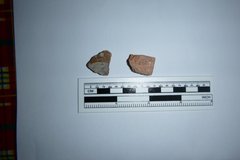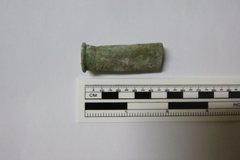Week 3 began with archaeologists continuing excavations of EU-1 and EU-2 [EU= excavation unit] (Figures 1 and 2). As depths increased, it became clear that EU-1 was entirely within disturbed soils. This means digging had previously occurred in this location, and the soils are now mixed. Figure 2 shows the various soil types on the surface of the level. However, the soils were intact in EU-2, which is only 50 cm (20 in) west of EU-1. This means these are the original soils deposited at this location. The disturbed soils of EU-1 and the intact soils of EU-2 continued until the termination of the units. This was an interesting discrepancy due to the close proximity of the two excavation units.
Mission Gate and Lunette Archaeology - December 16
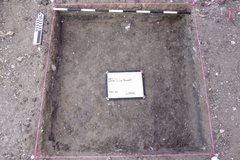
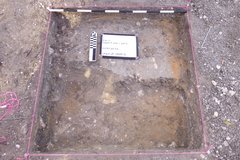
Excavations of both units ended when archaeologists encountered hardpan across the base of the units (Figure 3). A hardpan is a cemented or compacted, and often clayey layer in soil impenetrable by roots. The hardpan was at approximately the same level in both units, and the deepest point ranged from 72 to 80 cm (28 to 31 inches) below the surface.
Once digging was completed in the units, the archaeologists thoroughly documented the unit. Documentation includes detailed notes, photography, soil descriptions, and mapping of the base and walls of the units (Figure 4). Next week two additional excavation units will be opened.
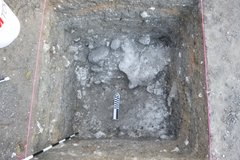
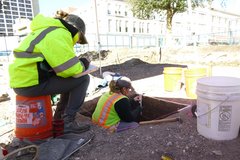
While excavations did not encounter the Mission complex's south wall, a couple of interesting artifacts were encountered. Two Spanish Colonial ceramic sherds were found from EU-1 (Figure 5). The Galera and Valero Red Painted ceramics were found in mixed deposits, not the location of the original deposition. Galera Ware is a thin ceramic that is believed to have originated from Jalisco, Mexico, and it is found at most Spanish Colonial sites in Texas. The most common vessel forms were bean pots, serving dishes and platters, cups, and chocolate pots. The sherd found in EU-1 appears to have a white dot decoration, which was a common motif in Galera Ware.
Similar to Galera Ware, Valero Ware has been encountered at Spanish Colonial sites throughout south Texas. However, this ceramic type has not been found anywhere outside of Texas. It gets its name from our very own Mission San Antonio de Valero, as it was first found here at the Alamo. This sherd from EU-1 is known as a Valero Red Painted because it was painted with red pigment and this example still has remnants of the paint! This ceramic type was wheel-thrown and unglazed. Because the potter's wheel was introduced to Texas by the Spanish, we know this ceramic type does not predate Spanish arrival.
Another fascinating find this week was a brass bullet casing (Figure 6). This casing was found in EU-2. There was only a single casing and no other related artifacts in the same depositional layer. The casing is likely from a 50-70 Government cartridge. This cartridge was adopted in 1866 to be used with the Springfield Model 1866 trapdoor rifle. The casing was officially used until 1873, though it may have been used into the 1880s in parts of the country. This date range corresponds to the occupation of the US Army at the Alamo site.
